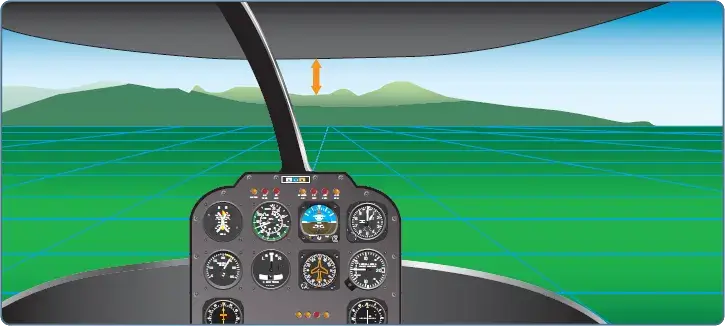Straight-and-level flight is flight in which constant altitude and heading are maintained. The attitude of the rotor disk relative to the horizon determines the airspeed. The horizontal stabilizer design determines the helicopter’s attitude when stabilized at an airspeed and altitude. Altitude is primarily controlled by use of the collective.
Technique
To maintain forward flight, the rotor tip-path plane must be tilted forward to obtain the necessary horizontal thrust component from the main rotor. By doing this, it causes the nose of the helicopter to lower which in turn will cause the airspeed to increase. In order to counteract this, the pilot must find the correct power setting to maintain level flight by adjusting the collective. [Figure]

When in straight-and-level flight, any increase in the collective, while holding airspeed constant, causes the helicopter to climb. A decrease in the collective, while holding airspeed constant, causes the helicopter to descend. A change in the collective requires a coordinated change of the throttle to maintain a constant rpm. Additionally, the antitorque pedals need to keep the helicopter in trim around the vertical axis.
To increase airspeed in straight-and-level flight, apply forward pressure on the cyclic and raise the collective as necessary to maintain altitude. To decrease airspeed, apply rearward pressure on the cyclic and lower the collective, as necessary, to maintain altitude.
Although the cyclic is sensitive, there is a slight delay in control reaction, and it is necessary to anticipate actual movement of the helicopter. When making cyclic inputs to control the altitude or airspeed of a helicopter, take care not to overcontrol. If the nose of the helicopter rises above the level-flight attitude, apply forward pressure to the cyclic to bring the nose down. If this correction is held too long, the nose drops too low. Since the helicopter continues to change attitude momentarily after the controls reach neutral, return the cyclic to neutral slightly before the desired attitude is reached. This principle holds true for any cyclic input.
Since helicopters are not very stable, but are inherently very controllable, if a gust or turbulence causes the nose to drop, the nose tends to continue to drop instead of returning to a straight-and-level attitude as it would on a fixed-wing aircraft. Therefore, a pilot must remain alert and fly the helicopter at all times.
Common Errors
- Failure to trim the helicopter properly, tending to hold antitorque pedal pressure and opposite cyclic. This is commonly called cross-controlling.
- Failure to maintain desired airspeed.
- Failure to hold proper control position to maintain desired ground track.
- Failure to allow helicopter to stabilize at new airspeed.
